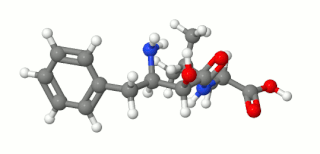In enzymology, a gentamicin 2"-nucleotidyltransferase is an enzyme that catalyzes the chemical reaction

Ubenimex (INN), also known more commonly as bestatin, is a competitive, reversible protease inhibitor. It is an inhibitor of arginyl aminopeptidase (aminopeptidase B), leukotriene A4 hydrolase (a zinc metalloprotease that displays both epoxide hydrolase and aminopeptidase activities), alanyl aminopeptidase (aminopeptidase M/N), leucyl/cystinyl aminopeptidase (oxytocinase/vasopressinase), and membrane dipeptidase (leukotriene D4 hydrolase). It is being studied for use in the treatment of acute myelocytic leukemia and lymphedema. It is derived from Streptomyces olivoreticuli. Ubenimex has been found to inhibit the enzymatic degradation of oxytocin, vasopressin, enkephalins, and various other peptides and compounds.

Antipain is an oligopeptide that is isolated from actinomycetes and used in biochemical research as a protease inhibitor of trypsin and papain. It was discovered in 1972 and was the first natural peptide found that contained an ureylene group. Antipain can aid in prevention of coagulation in blood. It is an inhibitor of serine and cysteine proteases.

Albomycins are a group of naturally occurring antibiotics belonging to the class of sideromycins, which are "compounds composed of iron carriers called siderophores linked to antibiotic moieties". They are particularly effective against Gram-negative bacteria of the family Enterobacteriaceae and few Gram-positive bacteria such s Streptococcus pneumoniae, Bacillus subtilis and Staphylococcus aureus. In 2000 a group of scientists from SmithKline Beecham Pharmaceuticals, UK reported that the antibiotic part of albomycin in vitro can inhibit seryl t-RNA synthetase from both eukaryotic and prokaryotic representatives.

Altemicidin is monoterpene alkaloid first identified in isolates from marine actinomycetes in 1989. It may also be produced synthetically. Altemicidin displays both acaricidal and antitumor activity.
Streptomyces coeruleorubidus is a bacterium species from the genus of Streptomyces which has been isolated from marine sediment. Streptomyces coeruleorubidus produces the following medications: pacidamycin 1, baumycin B1, baumycin B2, baumycin C1, feudomycin A, feudomycin B, feudomycin C, ficellomycin, feudomycinone A, and rubomycin.
Streptomyces diastatochromogenes is a bacterium species from the genus of Streptomyces. Streptomyces diastatochromogenes produces polyketomycin, concanamycin A, concanamycin B, concanamycin C, momofulvenone A, azdimycin, toyocamycin and oligomycins.
Streptomyces echinoruber is a bacterium species from the genus of Streptomyces which was isolated from soil in Argentina. Streptomyces echinoruber produces the red pigment rubrolone.
Streptomyces griseoaurantiacus is a thermotolerant bacterium species from the genus of Streptomyces which was isolated from marine sediment. Streptomyces griseoaurantiacus produces the antibiotics manumycin, diperamycin and chinikomycin, and griseolic acid.
Streptomyces griseoflavus is a bacterium species from the genus of Streptomyces which has been isolated from garden soil. Streptomyces griseoflavus produces bicozamycin, colabomycins A, colabomycins C, germacradienol and hormaomycin.
Streptomyces kasugaensis is a bacterium species from the genus of Streptomyces which has been isolated from soil from the city Nara in Japan. Streptomyces kasugaensis produces kasugamycin and thiolutin.
Streptomyces lavendofoliae is a bacterium species from the genus of Streptomyces which has been isolated from soil in Russia. Streptomyces lavendofoliae produces fosfazinomycin A, fosfazinomycin B and piperastatin B
Streptomyces longisporoflavus is a bacterium species from the genus of Streptomyces which has been isolated from soil. Streptomyces longisporoflavus produces tetronasin and staurosporine.
Streptomyces melanosporofaciens is a bacterium species from the genus of Streptomyces which has been isolated from soil in Italy. Streptomyces melanosporofaciens produces elaiophylin, cyclooctatin, geldanamycin, chilaphylin and melanosporin. A mutant of Streptomyces melanosporofaciens has the ability to protect potatoes from common scab.
Streptomyces nashvillensis is a bacterium species from the genus of Streptomyces which has been isolated from soil. Streptomyces nashvillensis produces tetrodecamycin and bellenamine.
Streptomyces nitrosporeus is a bacterium species from the genus of Streptomyces which has been isolated from garden soil in Japan. Streptomyces nitrosporeus produces Benzastatin E, Benzastatin F, Benzastatin G Nitrosporeusine A and Nitrosporeusine B and the antibiotics nitrosporin and virantomycin and the inhibitor of angiotensin-converting enzyme foroxymithine. Streptomyces nitrosporeus can degrade cellulose.
Streptomyces prunicolor is a bacterium species from the genus of Streptomyces which has been isolated from soil in Russia. Streptomyces prunicolor produces Pironetin and the free radical scavengers benthocyanin A, benthocyanin B and benthocyanin C.
Streptomyces rishiriensis is a bacterium species from the genus of Streptomyces which has been isolated from soil in Hokkaido in Japan. Streptomyces rishiriensis produces coumermycin A1, notomycin, 2-chloroadenosine, phosphophenylalanarginine and lactonamycin.
Streptomyces roseofulvus is a bacterium species from the genus of Streptomyces which has been isolated from soil. Streptomyces roseofulvus produces deoxyfrenolicin and frenolicin B.
Fostriecin is a type I polyketide synthase (PKS) derived natural product, originally isolated from the soil bacterium Streptomyces pulveraceus. It belongs to a class of natural products which characteristically contain a phosphate ester, an α,β-unsaturated lactam and a conjugated linear diene or triene chain produced by Streptomyces. This class includes structurally related compounds cytostatin and phoslactomycin. Fostriecin is a known potent and selective inhibitor of protein serine/threonine phosphatases, as well as DNA topoisomerase II. Due to its activity against protein phosphatases PP2A and PP4 which play a vital role in cell growth, cell division, and signal transduction, fostriecin was looked into for its antitumor activity in vivo and showed in vitro activity against leukemia, lung cancer, breast cancer, and ovarian cancer. This activity is thought to be due to PP2A's assumed role in regulating apoptosis of cells by activating cytotoxic T-lymphocytes and natural killer cells involved in tumor surveillance, along with human immunodeficiency virus-1 (HIV-1) transcription and replication.



